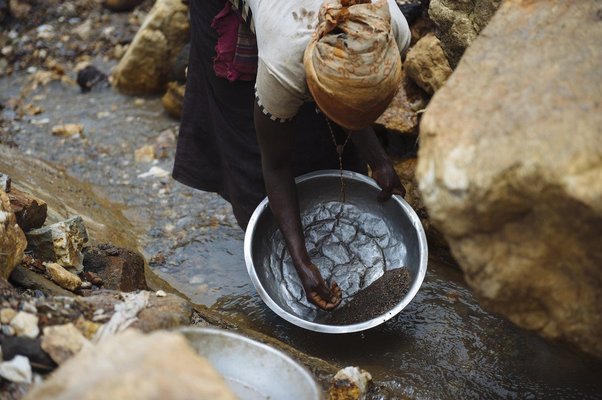- Government faces key test to retain control of country’s vast mineral wealth
- Lapis lazuli should now be known as a conflict mineral.
A new investigation today reveals how Afghanistan’s 6,500 year old lapis mines are driving corruption, conflict and extremism in the country. Global Witness has found that the Taliban and other armed groups are earning up to 20 million dollars per year from Afghanistan’s lapis mines, the world’s main source of the brilliant blue lapis lazuli stone, which is used in jewellery around the world. As a result, the Afghan lapis lazuli stone should now be classified as a conflict mineral.
The lapis mines are in the Badakhshan region, once one of the more stable areas in Afghanistan, even at the height of Taliban control. However, violent competition for control of the lucrative mines and their revenue, between local strong men, local MPs and the Taliban has deeply destabilised the province and made it one of the hotbeds of the insurgency. With the Taliban on the outskirts of the mines themselves, as well as controlling key roads into the mining areas, there is now a real risk that the mines could fall into their hands.
Global Witness’ investigation also includes evidence that the Badakhshan mines are a strategic priority for the so-called Islamic State [1]. Unless the Afghan government acts rapidly to regain control, the battle for the lapis mines is set to intensify and further destabilise the country, as well as fund extremism.
The lapis mines in Afghanistan’s Badakhshan region are a microcosm of a problem that is replicated across the country, where mining is the Taliban’s second biggest source of income. Money from Afghanistan’s mines should be an important source of wealth to fund essential services, including security, health and education. Afghanistan sits on over a trillion dollars’ worth of mineral, oil and gas deposits, which could provide the government with over $2 billion in revenue a year, if developed properly [2]. But rampant corruption and a failure to secure mining sites means that mines have been targeted by insurgent groups and are now a major contributor to conflict and extremism. The new Afghan mining law, which is currently being amended by the government, fails to include the actions needed to counter this threat, the report warns.
“These lapis mines are one of the richest assets of the Afghan people and should be driving development and prosperity” said Stephen Carter, Afghanistan Campaign Leader at Global Witness. “Instead, the beautiful lapis lazuli stone has become a conflict mineral. The mines provide a tiny fraction of the benefit they should, and have become a major source of conflict and grievance, which is driving the insurgency and undermining hope for stability in Afghanistan – which could have consequences globally.”
“Unless the Afghan government acts quickly, these mines represent not just a lost opportunity but a threat to the future of the whole country,” said Carter. “The Afghan government must urgently re-establish the rule of law at these mine sites, and strengthen oversight and transparency for mining across the country to make sure these natural resources serve the Afghan people to whom they belong.”
Global Witness is calling for the Afghan government and its international partners to make problems around mining in Afghanistan a critical priority in order to tackle this crisis. In particular, the current mining law fails to put in place the fundamental safeguards of transparency, accountability, and community engagement that are needed to secure and develop Afghanistan’s mining sector. Global Witness is calling for the government to ensure publication of mining data, reform mining oversight, and support community monitoring of mining.
“President Ghani has made a number of recent commitments at the Anti-Corruption Summit in London [3] which show he clearly understands the risks involved in Afghanistan’s mines. But, the Afghan government urgently needs to prioritise security in mining areas, as well as ensure that the mining law is actually fit for purpose. Currently, Afghanistan is still missing many of the basic protections that would help stop its mines, and the money from them, falling into the wrong hands” said Carter.
While the US government has also identified development of Afghanistan’s mining sector as key to ending the country’s dependence on foreign aid, Global Witness warns that they failed to pay sufficient attention to the security risks involved. The US has given nearly half a billion dollars in aid to the extractives sector since 2009 [4] in an attempt to jump-start Afghanistan’s mining sector but invested very little in tackling insecurity and weak governance.
The Chinese market is also a key driver for Afghanistan’s lapis mining, with the vast majority of lapis being exported to China where it is prized as jewellery. The fact that Chinese lapis sales are funding the Taliban comes in contrast to the Chinese government’s official position as peace-broker on Afghanistan in regional security talks.
“Governments around the world need to wake up to the fact that Afghanistan’s mines are driving conflict in the country and do something to stop this before even more of the mines falls into the hands of insurgents and armed groups” said Carter.
[1] Islamic State of Khorasan Province (IS-K), the Islamic State affiliate in Afghanistan
[3] AntiCorruption Summit – London 2016, Islamic Republic of Afghanistan: Country Statement
[5] James Kirkup, “Beautiful Gems Help Alliance Pay for 5-Year War”, Seattle Times, November 21, 2001
Notes to editor:
For a full copy of the report, click here.
The Kuran wa Munjan mines in Badakhshan region have been out of government control for over two years, and have been providing the Taliban with significant and growing income since this time. The Taliban are now taking more than 50% of the revenue from the mines. Previously, the Badakhshan region was one of the few provinces which resisted Taliban infiltration even at the height of their rule [5].
Badakhshan’s lapis lazuli mines have been active for 6,500 years, producing the semi-precious stone which is prized for its deep blue colour and which features on Tutankhamun’s funeral mask.
The mines were taken over in early 2014 by a former government district chief of police from the mining area, Commander Malek, who has reportedly been supported by the former Minister of the Interior and Defense Bismillah Khan. Before 2014 the mines were said to be controlled by Zulmai Mujadidi, a powerful Afghan MP from Badakhshan. His brother Asadullah Mujadidi was appointed to command the Mining Protection Force to protect the mines, but the Global Witness investigation suggests that he instead used his position to extract profits on his own behalf and that of his allies rather than on behalf of the Afghan government or local populace. Zekria Sawda, another MP from Badakhshan and the Head of the Natural Resource and Environmental Commission in the Lower House of Parliament, controlled a tourmaline mining contract in Badakhshan and had close links with Zulmai Mujadidi.
Zekria Sawda and Asadullah Mujadidi both deny involvement in mining in Badakhshan, or with illicit armed groups. Zulmai Mujadidi also strongly denied the allegations, which he said were propaganda which “originated from or [was] influenced by my political opponents.” General Mohammadi did not comment, while Commander Malek could not be reached to request his views.
Armed groups took nearly $20 million from these mines in 2014, including an estimated $1m to the Taliban, whilst the Afghan government earned only $20 million in declared extractives revenue across the whole of Afghanistan in 2013, the most recent year that official government mining revenue data is available. The proportion of income from the lapis mines going to the Taliban has continued to increase, with them taking around $4m in 2015. As of mid-2016, they were taking more than 50% of the direct revenue from the mines.
The Afghan government imposed a ban on the lapis trade and extraction in early 2015, and closed the main transit route for lapis through Faizabad. Since then, the trade has continued virtually unchecked, albeit at a reduced volume, through smuggling over the Anjuman pass to Panjshir – the most secure province in the country
The so-called resource curse has been identified by academics as a situation where, in countries with an abundance of natural resource wealth but weak institutions, the struggle to control that natural resource wealth instead exacerbates corruption, decreases economic and political development outcomes, and can increase the frequency, severity and duration conflict.


